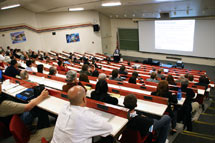
Handy Links
SLAC News Center
SLAC Today
- Subscribe
- Archives: Feb 2006-May 20, 2011
- Archives: May 23, 2011 and later
- Submit Feedback or Story Ideas
- About SLAC Today
SLAC News
Lab News
- Interactions
- Lightsources.org
- ILC NewsLine
- Int'l Science Grid This Week
- Fermilab Today
- Berkeley Lab News
- @brookhaven TODAY
- DOE Pulse
- CERN Courier
- DESY inForm
- US / LHC
SLAC Links
- Emergency
- Safety
- Policy Repository
- Site Entry Form

- Site Maps
- M & O Review
- Computing Status & Calendar
- SLAC Colloquium
- SLACspeak
- SLACspace
- SLAC Logo
- Café Menu
- Flea Market
- Web E-mail
- Marguerite Shuttle
- Discount Commuter Passes
-
Award Reporting Form
- SPIRES
- SciDoc
- Activity Groups
- Library
Stanford
Around the Bay
LCLS/SSRL Users' Meeting Covers Recent Successes and Future Plans
Last week's Linac Coherent Light Source and Stanford Synchrotron Radiation Lightsource Users' Meeting packed more than 30 opening and plenary presentations and 60 breakout workshop talks into four and a half days, offering LCLS and SSRL users and staff the opportunity to learn about the latest plans, developments and user research at SLAC's lightsource facilities.
"It's really been an extraordinary year here at SLAC," SLAC Director Persis Drell said in her opening talk. "A year ago, the LCLS was just starting user-assisted commissioning, and we really were wondering how it was all going to go. It's gone brilliantly. In the past year we've also built the strongest possible team to lead SSRL into the future, while being mindful of the needs of its users."
The past year, Drell said, has seen more than 90 percent of scheduled beamtime delivered to LCLS end stations, and in that time the machine has been "operating more reliably and with far more flexibility than we had any right to expect." Meanwhile, SSRL delivered more than 95 percent of scheduled beamtime, serving more than 1400 users at 26 experimental end stations.
"We are very excited about the near- and long-term future of SLAC," Drell told attendees, "and we are thrilled to have you here to share it with us."
Excitement about the science made possible by recent and future expansions at SLAC's lightsources carried throughout the conference. LCLS has already proven itself to such an extent, LCLS Director Jo Stöhr said, that the laboratory has been encouraged to think about upgrades to the lightsource. LCLS is currently able to schedule beam time for one-quarter to one-fifth of the proposals submitted. Yet in the latest round of submissions, the Proposal Review Panel judged 95 percent of proposals worthy of beam time.
"It's good that a lot of people want to use LCLS, but it's also a challenge because a number of good proposals must be turned down," he said. In the coming years, as additional instruments begin operation and as LCLS-II becomes a reality, Stöhr looks forward to increasing the number of users who participate in experiments at LCLS.
SSRL Director Chi-Chang Kao and Deputy Director Piero Pianetta discussed SSRL's recent successes, including the start of frequent injection of electrons into the SSRL ring and the numerous accelerator, infrastructure and beamline upgrades that will allow the lightsource to start operations next month at 350 mA—nearly twice the integrated current that SSRL users saw at the beginning of the 2009 run. By the end of the upcoming user run, Pianetta said, this number will increase to 500 mA.
In the next five to 10 years, Kao said he would like to see SSRL offer additional experimental capabilities in targeted areas, attract more top scientists and users, establish a record of high-profile science and establish a long-term plan. "Growth in synchrotron science is limited by resources, not by demand," Kao said. He emphasized that synchrotrons support a very wide variety of science topics—including work that focuses on materials and energy problems—and SSRL staff members should continue working with the user community to define the technology and tools needed to solve society's problems.
In addition to overviews of SLAC's lightsource programs, the meeting also offered SLAC staff and users a chance to hear about the Department of Energy's motivations and plans in the coming years. "In the past two decades, the U.S. has developed and deployed the world's most powerful collection of research facilities for materials and chemical sciences," said Harriet Kung, DOE Associate Director of Science for Basic Energy Sciences. "The success we have seen at this laboratory really describes… the way in which BES would like to be the steward of most transformative discoveries. We're really proud to be a part" of science at SLAC.
"In the next couple of years," Kung continued, "we look forward to partnering with Jo and Chi-Chang, Persis and SLAC to ensure we position ourselves to have the most advanced facilities and make them available to the broader community."
—Kelen Tuttle
SLAC Today, October 26, 2010
